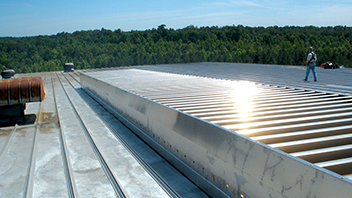Natural Ventilation Definition – What it Means
Natural ventilation definition: the process of pulling fresh air into a building from the outside. In turn, this fresh air helps force the warm, dirty air inside of the building out through the opening in the roof. This becomes done, without mechanical assistance. While that is the definition, concisely, it’s actual application and use is much more complex.
There are two types of ventilation that occur naturally in buildings. There is wind-based ventilation (also known as cross ventilation) and Buoyancy-driven ventilation (also known as stack-effect ventilation.)
Wind-Based Ventilation (Cross-Ventilation)
Natural Ventilation Definition – Cross Ventilation: Wind moving past a building will create different areas of high and low pressure. The windward side of the building is an area of high pressure while the leeward side & roof are low pressure. Strategically placing different sizes and types of openings in the high and low-pressure areas cause air to move through the building at an increased rate and in the desired direction.
The easiest way to understand wind-based or wind-driven ventilation is to look at an open window. Fresh air comes in through one side, moves throughout the building, and then goes out through the opposite side, pushing the stagnant warm air that was in the building along with it. Additionally, this is a great, low-cost ventilation solution in certain facilities.
However, it should be noted that wind-based ventilation isn’t always ideal in areas where there’s a lot of pollution or dust. It also doesn’t work in areas where the wind is not favorable, i.e. wind blows in the opposite direction and has no effect. Wind-based ventilation can also cause a building to particularly draughty, which can be problematic in the winter months as well.
Buoyancy-Driven Ventilation (The Stack Effect)

Natural Ventilation Definition – Buoyancy-Driven Ventilation: It seems complicated, but it works like a fireplace. Because warm air rises and cool air stays low, this process forces warm air up.
Heat generated within buildings rises towards the ceiling. In large buildings, where the structure is of significant height, the natural tendency of warm air to rise generates air movement throughout the entire building. This is what is commonly known as thermal buoyancy or the stack effect. Warm air rises through the structure and escapes via the natural ventilator. The wall louvers at the floor level allow cool air to enter, replacing the warm air that escapes.
The tall roofs of industrial buildings create substantial differences in temperatures and pressures, which is why industrial sites are ideal locations for gravity ventilation systems. Exploit these differences to direct air up and out of the building naturally.
Unlike cross-ventilation, this method can still work on cool and calm days. For natural ventilation, all year-round buoyancy-driven ventilation is the right choice.
Combined Ventilation
Powered Ventilation Definition: Using powered equipment, such as fans, to move air and lower temperatures in your building. Powered ventilation is the only option in some spaces. Facilities that use chemicals or have lower ceilings height or just don’t produce quite enough heat require powered ventilation. There are a lot of reasons why powered ventilation may be necessary.
Hybrid Ventilation Definition: using a combination of Natural Ventilators and powered ventilation to keep the entire building comfortable throughout the day. Combined ventilation gives you the best of both worlds. Finally, you’ll reduce operating costs, keep air quality high, and make sure you’re following all necessary healthy and safety guidelines in your area. More and more plant managers are going with systems that use a natural solution for larger areas, and powered ventilation for work rooms and smaller areas throughout their facilities.
Natural Ventilation Definition Information
In almost any building wind-based ventilation can be an immense help. Finding the right ventilation system for your facility is key, and Moffitt is here to help. If you think your facility could benefit from a natural ventilation system contact us today. Finally, we can help you design the system that’s right for your building’s needs.
